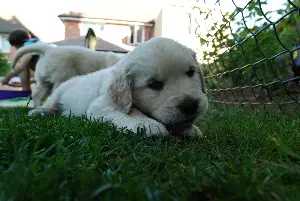
8 weeks is a very key time for a puppy.
It’s the age they mature and leave their mother and littermates behind to go to a new home.
It’s at this point they’re weaned off their mother’s milk to eat solid food for the first time.
It’s well known that dogs love chewing raw bones.
But at what age can they actually start doing so?
Can they go into it straight away or should owners practise caution?
Why would you give an 8-week-old puppy a bone?
Bones have a multitude of benefits for dogs. As the puppy is moving out of its infancy stage it requires as many nutrients as possible to aid growth.
It’s understandable to imagine why giving your puppy bones to chew will help it along the way. However, it does more harm than good.
Your 8-week-old puppy’s teeth are not yet developed.
Chewing bones can cause damage. The teeth are also incredibly sharp, which increases the risk of the bone breaking and possibly ending up as a fragment in the stomach.
They could also choke on this.
Can I give my 8-week-old puppy bones?
If you’ve decided to let your puppy chew on bones, wait until they’ve passed their teething stage.
This is typically between 12 and 24 weeks.
Only then give them raw bones and ensure they’re stored properly to prevent bacteria from forming.
When you follow the safety steps, your dog can enjoy all the delicious nutrients a fresh bone has to offer.
How strong are an 8-week-old puppy’s teeth?
Your puppy’s teeth go through a similar process as those of humans’.
They have weak milk teeth, which eventually give way to permanent gnashers. This is partly why they should not be given bones.
The full set of 28 milk teeth is expected around the 6 week mark.
A dog can expect to have grown all their adult teeth (42 to be exact) by the age of six months.
Milk teeth are weaker than permanent adult teeth. This is partly because the enamel covering on milk teeth is thinner than it is on permanent teeth.
Chewing on bones can test the strength of even a healthy set of adult teeth and I have never let one of my puppies gnaw on a bone.
Another possible reason for not providing your eight week puppy with a bone is because their teeth are sharp.
With good reason.
Some experts believe that the sharpness is so they can practise bite inhibition.
And that it’s only through biting with sharp teeth that they learn when not to do so. A quick nip of their littermate or owner will set them right!
Having had several litters of puppies myself, I also wonder if puppies have sharp teeth to aid the weaning process.
A puppy’s teeth are so sharp that it becomes too painful for the mother dog to keep feeding them.
And if eight week old puppies are gnawing on bones, their teeth might become less sharp which would interfere with these natural processes.
What are the best chew toys for an 8-week-old puppy?
Now we’re seeing that bones are probably not suitable for an 8-year-old pup, just what can they chew on? Are they allowed to chew at all? They absolutely are!
Wishbone-shaped chew toys are specifically designed for teething puppies. They’re also made of heavy-duty nylon which can withstand bites.
Rubber teething chew toys are a great option.
Puppy teething sticks have the same benefits. Both work on dogs the same way a dummy would for babies.
They help to satisfy instinctual needs and provide mental stimulation.
When they’re finished chewing, drive your dog crazy by smearing peanut butter on the inside of the toy and throwing it.
Then watch them run wild.
At what age can you start giving your puppy bones?
If you do decide to give your dog a bone, it’s best to get the timing right. 8 weeks is a bit early to allow your pup to chew on a bone. Their milk teeth will likely become damaged with vigorous chewing.
The peak of your puppy’s teething activity is between 12 and 24 weeks. At six months, it’s expected all adult teeth will be in place.
It’s best to stay risk-free and only give your dog a bone once all of their adult teeth are in place.
Don’t forget to avoid cooked bones. Uncooked chicken, beef or lamb bones are the best options for your dog.
Raw bones offer no risk of being splintered once chewed, plus they have many health benefits.
It’s best to keep an eye on your pup whilst chewing, and for an hour or so afterwards.
This is to be sure a part of the bone doesn’t become dislodged, which could prove to be a choking hazard.
It’s therefore recommended to avoid letting them have the bone at night.
What other ways are there to keep an 8-week-old puppy from getting bored?
Bones and chews are great ways of holding a puppy’s attention and stopping boredom from setting in.
The good news is these are not the only way of stopping them from getting restless.
Ensure your puppy has several toys with as much variety as possible.
A tennis ball, tug of war rope and a squeaky teddy bear is a good place to start.
Once you’ve amassed plenty of each type, rotate them so your puppy doesn’t grow restless.
Getting outside as much as possible will always be the best solution to boredom.
Dogs’ obsession with smelling lampposts and well, pretty much everything, stems from the fact they smell to perceive the world.
Dogs also love to run around and seek out social time with other dogs. An hour’s walk with plenty of smells will settle your pup.
How can you tell a puppy is getting bored?
If your dog starts barking at nothing, running around the house or chewing every item of furniture, these are signs they’re getting bored.
Once you spot one of these signs, it’s time for the chews, the toys or the outside walk. Now you know why they love bones so much!
What’s so good about bones?
What do dogs love about bones anyway? Firstly, it’s the taste. They go straight for the bone marrow, which is buttery and semi-sweet. Plus there’s the added benefit of any meat left on the bone.
Chewing bones also alleviates boredom and stimulates the release of endorphins. This means dogs associate chewing with happiness. It also provides dental benefits, removing plaque and reducing bad breath.
Are bones the perfect snack for dogs then?
Unfortunately, bones do not come without risk. Bones contain a lot of bacteria and chewing them can lead to a bad stomach and diarrhoea. Some dogs don’t have strong enough teeth for chewing, so there is the risk of painful broken teeth and a hefty veterinarian bill.
There are even tales of pieces of bone fragments causing incisions in dogs’ stomachs.
Are any bones suitable?
You may be wondering whether dogs can chew any type of bone. There is a lot of conflicting information out there but the real answer is, unfortunately not.
Freshly cooked bones are full of risks. They can easily splinter and cause a dog a whole host of problems including a blockage in their windpipe, rectal bleeding or peritonitis.
Contrary to popular belief, shop-bought and rawhide bones can also pose high risks.
The manufacturing process of the bones (smoking and seasoning) can leave trace toxic chemicals, which can cause contamination with E.coli or Salmonella.
Also, rawhide bones contain additives and preservatives which can lead to toxic poisoning or cancer.
What are the best types of bones for dogs?
Most raw bones that have not undergone any cooking process are perfectly edible for dogs. Leftover bones from your butchers with meat and cartilage still attached are safe.
Uncooked chicken, beef or lamb bones are good options. Raw bones are also a natural source of calcium and phosphorus.
The only thing to watch out for is that the bone is stored correctly and kept out of sunlight. Make sure you refrigerate between use and dispose of after three days.
Whilst the bones are generally safe, the fragments of meat do still carry the risk of bacterial infection if not properly handled.
What time of the day should I give my dog a bone?
Due to the potential choking hazard, avoid letting your pup chew their bone before bedtime.
Instead, bones should be enjoyed immediately after mealtimes.
If your pup is hungry, they may be too vigorous with the bone.
It’s good to set boundaries with the bone. Remove it from your dog after 10-15 minutes, then place it in the refrigerator to ensure it doesn’t go off.
How many bones should my puppy have in a week?
If you’re worried about how many bones you should allow them, the general guidance is two per week. Each portion should be spaced out as much as possible.
Try to create some boundaries with your pup and allow them to understand it’s an occasional treat.
Training and perseverance are required here, just like toilet training and rewarding good behaviour with treats!
What alternatives to bones are available?
Toys specifically for teething can provide a good alternative to bones. But is there anything similar that’s food-related?
Carrots are a really good choice.
They’re tough enough for your puppy to find them an interesting challenge, plus they’re packed with nutrients.
There’s also no chance of your dog suffering any harm from a carrot.
Dentastix is also a very safe option.
Of course, any chewable item is not completely risk-free and your dog should be monitored at all times whilst chewing.
Dentastix are low in fat, sugar-free and they also have excellent dental benefits. They are also free from artificial colours and junk.




